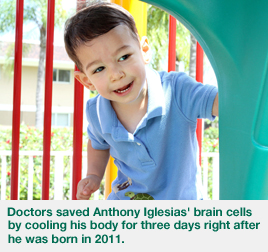April 7, 2020 by John Fernandez
Cool Treatment Helps Babies Survive

 When Anthony Iglesias was born on Thanksgiving Day 2011, neither his delivery nor the next 72 hours were what his parents expected.
When Anthony Iglesias was born on Thanksgiving Day 2011, neither his delivery nor the next 72 hours were what his parents expected.
During his birth at South Miami Hospital, Anthony’s brain was deprived of blood and oxygen leading to a condition known as hypoxic ischemic encephalopathy, which accounts for nearly 25 percent of the world’s 4 million neonatal deaths each year. For those babies who do survive, many suffer significant and ongoing problems, such as mental retardation, seizures or cerebral palsy.
In Anthony’s case, the hospital’s Neonatal Intensive Care Unit (NICU) offered neonatal therapeutic hypothermia, or whole-body cooling for newborns.
“Hypothermia treatment has been used for heart attack patients for several years now,” said neonatologist Jorge Perez, M.D., medical director of South Miami Hospital’s NICU, within its Center for Women & Infants. “We first used it to treat oxygen-deprived newborns in 2010, being among the first to adapt the treatment for newborns who are born in such a fragile state.”
Because treatment has to be started no more than six hours after birth, Anthony’s medical team had to act right away. His parents, Jasmin Ibarrondo and Yasser Iglesias, readily gave their consent to the treatment.
“I had just had a C-section and wasn’t feeling so great, but the doctor helped me understand how serious Anthony’s condition was,” said Ms. Ibarrondo. “We trusted the doctor’s recommendation and put our faith in the medical team.”
With neonatal therapeutic hypothermia, an oxygen-deprived infant is placed on a cooling blanket to decrease the baby’s body temperature to approximately 90 to 92 degrees Fahrenheit for 72 hours. The three-day cooling period protects the baby’s brain by slowing the progressive death of brain cells that tends to occur following lack of blood and oxygen.
Nurses monitor temperature, brain activity, breathing and other vital functions around the clock. They also look out for side effects such as abnormally slow heartbeat, blood clots, seizures or skin complications. Nourishment, fluids, pain medication, and when necessary, anti-seizure medications, are administered intravenously.
After three days, the baby’s body temperature is gradually warmed over 24 hours. During the re-warming, blood circulation and oxygen flow to the brain return to normal levels.
The George Batchelor and Gloria Vasta Lewis Neonatal Intensive Care Unit (NICU) at Baptist Children’s Hospital also offers therapeutic hypothermia to newborns with hypoxic ischemic encephalopathy.
Once Anthony was brought out of the cooling, he spent another 21 days in South Miami Hospital’s NICU.
“That was a difficult time,” Ms. Ibarrondo recalls. “His recovery process felt so slow—one or two days turned into more days, and then weeks. He was so frail. I wasn’t even able to hold him until he was two weeks old.”
But when Anthony went home for the first time, 10 days before Christmas, his parents were overjoyed.
“We were so excited and nervous. He was finally home with us, and I felt the real joy of being a new mom.”
top stories












There are no comments